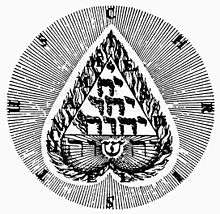Yahshuah
The pentagrammaton (Greek: πενταγράμματον) or Yahshuah (Hebrew: יהשוה) is a constructed form of the Hebrew name of Jesus originally found in the works of Athanasius Kirchner, Johann Baptist Grossschedel (1619) and other late Renaissance esoteric sources. It is to be distinguished from the name Yahshua found in the works of the Sacred Name movement in the 1960s, though there has been some conflation or confusion between the two. The pentagrammaton Yahshuah has no support in archeological findings, such as the Dead Sea scrolls or inscriptions, nor in rabbinical texts as a form of Joshua. Scholarship generally considers the original form of Jesus to be Yeshua, a Hebrew Bible form of Joshua.[1]
The essential idea of the pentagrammaton is of an alphabetic consonantal framework Y-H-Sh-W-H, which can be supplied with vowels in various ways. (Also, the "W" can be converted into a "U", since the Hebrew letter ו waw writes either a [w] consonant sound — later on pronounced [v] — or a long [u] vowel sound: see Mater Lectionis.)
Renaissance occultism


The first ones to use a name of Jesus something like "Yahshuah" were Renaissance occultists. In the second half of the 16th century, when knowledge of Biblical Hebrew first began to spread among a significant number of Christians, certain esoterically minded or occultistic circles came up with the idea of deriving the Hebrew name of Jesus by adding the Hebrew letter shin ש into the middle of the Tetragrammaton divine name yod-he-waw-he יהוה to produce the form yod-he-shin-waw-he יהשוה.
This was given a basic Latin transliteration JHSVH or IHSVH or IHSUH (since there was no letter "W" or sh / [š] sound in Latin, and "I" and "J" were then not yet clearly distinguished as letters of the alphabet, nor were "U" and "V"). This could then be supplied with further vowels for pronounceability. It was a coincidence that the first three letters of this consonantal transcription IHSVH etc. were identical with the old IHS/JHS monogram of the name of Jesus (from Greek iota-eta-sigma).
In Renaissance occultistic works, this pentagrammaton (or five-letter divine name) was frequently arranged around a mystic pentagram, where each of the five Hebrew letters י ה ש ו ה was placed at one of the points (the letter shin ש was always placed at the upward-pointing vertex of the pentagram).[2] One of the earliest attested examples of this diagram is in the Calendarium Naturale Magicum Perpetuum or "Magical Calendar" (published 1620 but dated 1582)[3] of either Theodor de Bry (Flemish-born German, 1528–1598) or Matthäus Merian the Elder (Swiss, 1593–1650).[4] This idea of the pentagrammaton was funneled into modern occultism by 19th-century French writer Eliphas Levi and the influential late 19th-century Hermetic Order of the Golden Dawn. The Golden Dawn favored the consonantal transcription IHShVH or YHShVH, and the pronunciation Yeheshuah.
However, in all early Hebrew or Aramaic sources, the name "Jesus"/"Jeshua" actually appears as yod-shin-waw-`ayin ישוע Yeshua (or as the related longer form of the same name, yod-he-waw-shin-`ayin יהושע "Joshua"; or as the intentionally altered derogatory Talmudic variant yod-shin-waw ישו Yeshu), so that the Renaissance speculations were incorrect. Note that the letter `ayin ע was specifically pronounced as a voiced pharyngeal consonant sound in ancient Hebrew and Aramaic, and could not be easily confused with either a pronounced [h] sound or a silent Hebrew letter he ה.
Modern "Divine Name" groups
Some modern religious groups have speculated that the most correct form of the Hebrew name of Jesus should be based on the spelling yod-he-shin-waw-`ayin יהשוע (apparently a reordering of the letters in the Hebrew spelling of the name yod-he-waw-shin-`ayin יהושע, pronounced [yěhōšūǎ`] and usually translated into English as "Joshua", but closely connected with the Hebrew form of the name of Jesus). This Hebrew letter sequence yod-he-shin-waw-`ayin can be transcribed into English in various ways (since Masoretic Niqqud is rejected), including Yahshua, Yahoshua, etc. — see Yahshua.
When a final "H" is added on to these transcriptions (e.g. Yahshuah, Yahoshuah etc.), or when such consonantal transcriptions as YHSWH or YHShWH are used (both quite similar to the old transcription JHSVH, given the differences between the English and Latin uses of the alphabet), then it seems rather clear that there is confusion between the name of Jesus and the Tetragrammaton (whether under the influence of the old occultistic "Pentagrammaton", or independently). The consonantal transcription YHShVH is used both by occultists and Divine Name religious adherents.
| Wikimedia Commons has media related to Pentagrammaton. |
See also
References
- ↑ Ilan, Tal (2002). Lexicon of Jewish Names in Late Antiquity Part I: Palestine 330 BCE-200 CE (Texte und Studien zum Antiken Judentum 91). Tübingen, Germany: J.C.B. Mohr. p. 129.
- ↑ Byzant Symbols
- ↑ "Bernard Picart and the first global vision of religion" - Page 158 Lynn Avery Hunt, Margaret C. Jacob, W. W. Mijnhardt - 2010
- ↑ The Wroclaw codex of the Magical Calendar
External links
- The correct form of the name of Jesus in several Semitic languages
- Jesus or Yahshuah?, argument for use of Hebrew name of Yahshuah